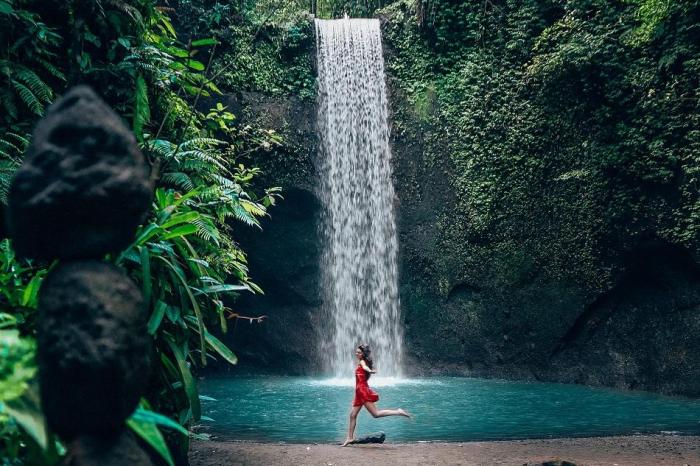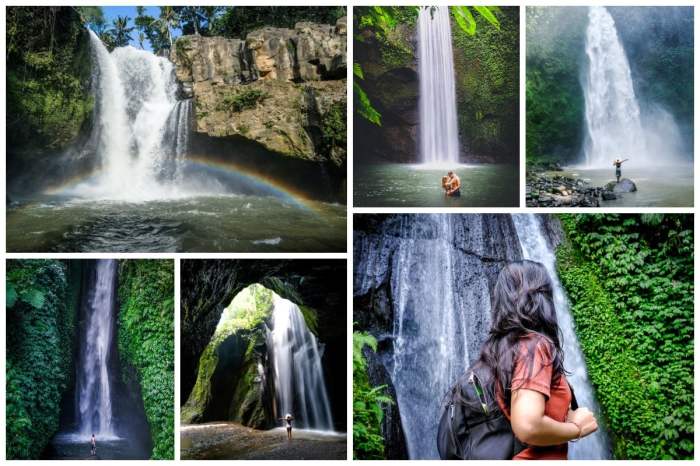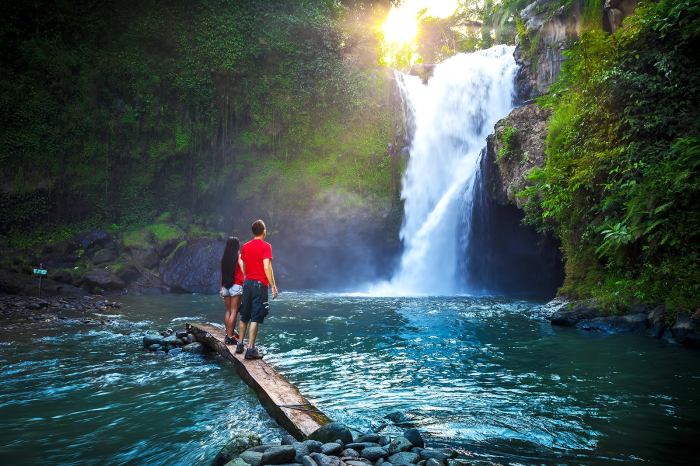Waterfall Ubud, nestled amidst the lush rainforests of Bali, beckons travelers with its captivating beauty and profound cultural significance. Its cascading waters, verdant surroundings, and ancient legends weave an enchanting tapestry that invites exploration and reflection.
From its geological origins to its role in Balinese spirituality, Waterfall Ubud offers a multifaceted experience that transcends mere sightseeing. Immerse yourself in its natural splendor, delve into its cultural heritage, and discover the enduring allure that has made it a beloved destination for centuries.
Waterfall Ubud

Nestled in the heart of Ubud, Bali, Waterfall Ubud is a mesmerizing natural wonder that attracts visitors from far and wide. With its towering height and cascading waters, the waterfall offers a breathtaking spectacle that is both awe-inspiring and tranquil.
History and Cultural Significance
Waterfall Ubud has a rich history and cultural significance in the region. According to local folklore, the waterfall is believed to be the abode of a sacred spirit named Dewi Danu, the goddess of water. The waterfall is also considered a sacred site by the local Balinese people, who often perform religious ceremonies and offerings at its base.
Natural Features of Waterfall Ubud

Waterfall Ubud is a mesmerizing natural wonder that attracts visitors from around the world. Its captivating beauty is a result of unique geological processes and a thriving natural environment.
Escape the bustling city of kuala lumpur and immerse yourself in the serene beauty of Waterfall Ubud. Surrounded by lush greenery, this natural wonder cascades over several tiers, creating a breathtaking spectacle. Take a refreshing dip in its crystal-clear waters or simply relax and soak up the tranquil atmosphere as the sound of the waterfall fills the air.
The waterfall cascades down from a height of approximately 30 meters, creating a breathtaking spectacle. Its width varies depending on the season, ranging from 10 to 15 meters. The flow rate is influenced by rainfall patterns, with the wet season witnessing a more powerful and voluminous cascade.
The enchanting waterfall Ubud in Bali is a breathtaking natural wonder that cascades down lush greenery, creating a symphony of sights and sounds. While it may not rival the architectural marvel of marina bay sands singapore , with its iconic infinity pool and stunning city views, waterfall Ubud offers a serene escape amidst the island’s tropical paradise, where the only distractions are the gentle rustling of leaves and the calming flow of water.
Geological Processes
The formation of Waterfall Ubud can be attributed to the erosion of limestone bedrock by the Wos River over millions of years. The river’s relentless flow has carved out a deep gorge, creating the dramatic cliffs and the waterfall itself.
Surrounding Natural Environment
The waterfall is nestled amidst a lush tropical rainforest, teeming with diverse flora and fauna. The surrounding vegetation provides a verdant backdrop to the waterfall, with towering trees, vibrant ferns, and colorful orchids adding to its scenic charm.
The area is also home to a variety of wildlife, including monkeys, birds, and reptiles. The harmonious coexistence of these species contributes to the ecological richness of the region.
Cultural and Spiritual Significance of Waterfall Ubud
For the Balinese people, Waterfall Ubud holds immense religious and cultural significance. It is believed to be a sacred site where the gods reside, and the waterfall’s waters are considered holy.
According to local legend, the waterfall was created by the Hindu god Indra as a gift to his wife. It is said that Indra was so smitten by his wife’s beauty that he created the waterfall to bathe her in its pure waters.
Religious Ceremonies and Rituals
Waterfall Ubud is a popular destination for Balinese religious ceremonies and rituals. The waterfall’s waters are believed to have healing properties, and many people come to bathe in them to cleanse themselves of impurities.
The waterfall is also a popular place for meditation and prayer. Many people come to the waterfall to seek guidance from the gods or to offer their thanks for blessings received.
Tourism and Accessibility of Waterfall Ubud

Waterfall Ubud attracts a significant number of tourists, both domestic and international. Its popularity has led to the development of infrastructure and amenities to cater to visitors.
Accessibility
The waterfall is easily accessible by road or public transportation. Several hiking trails lead to the waterfall, offering scenic views of the surrounding rainforest.
Amenities
The area surrounding the waterfall has been developed with amenities for tourists, including parking, restrooms, and food stalls. Visitors can also find local guides who can provide information about the waterfall and its cultural significance.
Tourism Impact
The increased tourism at Waterfall Ubud has had a positive impact on the local economy. However, it has also raised concerns about the potential negative effects on the environment and the cultural heritage of the area.
Waterfall Ubud in Art and Literature

Waterfall Ubud has captured the imagination of artists and writers for centuries, inspiring numerous paintings, photographs, and literary works. These artistic representations showcase the waterfall’s natural beauty, cultural significance, and symbolic meanings.
Paintings and Photographs
Ubud Waterfall has been a popular subject for painters and photographers due to its picturesque beauty. Artists have depicted the waterfall in various styles, from realistic landscapes to abstract interpretations. One notable painting is “Waterfall Ubud” by Balinese artist I Wayan Wija, which captures the waterfall’s cascading waters and lush surroundings in vibrant colors.
The cascading waters of Waterfall Ubud create a breathtaking spectacle, plunging into a serene pool below. Its beauty rivals that of the iconic statue of liberty , a symbol of freedom and democracy. As the sun dips below the horizon, the waterfall transforms into a canvas of vibrant hues, casting a mesmerizing glow upon the surrounding rainforest.
Photographers have also captured stunning images of the waterfall, showcasing its grandeur and serenity.
Literary Works
Waterfall Ubud has also featured prominently in literary works, serving as a setting or inspiration for poems, short stories, and novels. In Balinese literature, the waterfall is often associated with sacred rituals and spiritual purification. For example, in the novel “The Waterfall of Tears” by Balinese author Ketut Suardana, the waterfall is a place where characters seek solace and redemption.
Symbolism and Cultural Significance, Waterfall ubud
In both art and literature, Waterfall Ubud carries significant symbolism and cultural meaning. The waterfall represents the power and beauty of nature, as well as the interconnectedness of all living things. It is also associated with spiritual purification and renewal, as the cascading waters wash away impurities and symbolize the rebirth of the soul.
Conservation and Preservation of Waterfall Ubud

Recognizing the ecological and cultural significance of Waterfall Ubud, efforts have been made to protect and preserve this natural wonder.
The local community and government authorities have implemented measures to mitigate the impact of human activities on the waterfall and its surroundings.
Threats and Challenges
- Pollution:Improper waste disposal and agricultural runoff pose threats to the water quality of the waterfall and its surrounding ecosystem.
- Deforestation:Clearing of forests for agricultural expansion or development can lead to soil erosion, affecting the water flow and stability of the waterfall.
- Climate Change:Rising temperatures and altered precipitation patterns can impact the water flow and vegetation around the waterfall, potentially affecting its overall health and beauty.
Conservation and Preservation Efforts
- Waste Management:Waste bins and recycling programs have been introduced to reduce litter and prevent pollution.
- Reforestation:Afforestation and reforestation initiatives aim to restore and protect the surrounding forest, mitigating soil erosion and maintaining water quality.
- Sustainable Tourism:Promoting responsible tourism practices, such as staying on designated trails, avoiding littering, and respecting local customs, helps minimize the impact on the environment.
Best Practices for Responsible Tourism and Environmental Conservation
- Dispose of waste properly in designated bins or carry it out with you.
- Stay on designated trails to avoid trampling vegetation and disturbing wildlife.
- Respect local customs and traditions to preserve the cultural heritage of the area.
- Support local businesses and initiatives that prioritize sustainability.
- Educate others about the importance of preserving natural resources and encourage responsible behavior.
Final Summary
Waterfall Ubud stands as a testament to the harmonious coexistence of nature and culture. Its pristine waters, sacred significance, and captivating beauty continue to inspire awe and wonder in all who visit. As we bid farewell to this enchanting realm, let us carry with us the lessons it imparts about the interconnectedness of all things and the importance of preserving our natural and cultural treasures for generations to come.
Questions and Answers
How do I get to Waterfall Ubud?
You can reach Waterfall Ubud by car, motorbike, or taxi from Ubud town. The journey takes approximately 30 minutes.
Is there an entrance fee for Waterfall Ubud?
Yes, there is a small entrance fee to enter the area surrounding Waterfall Ubud.
What is the best time to visit Waterfall Ubud?
The best time to visit Waterfall Ubud is during the dry season (April-October) when the weather is clear and the waterfall is at its most impressive.